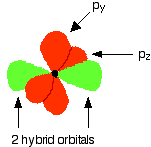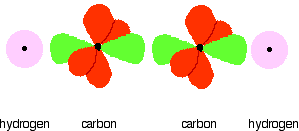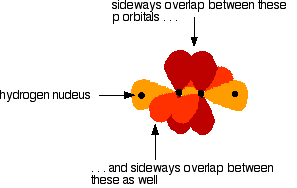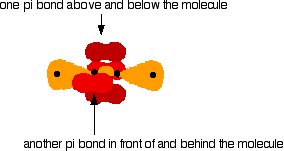|
Ethyne, C2H2
The simple view of the bonding in ethyne Ethyne has a triple bond between the two carbon atoms. In the diagram each line represents one pair of shared electrons. An orbital view of the bonding in ethyne Ethyne is built from hydrogen atoms (1s1) and carbon atoms (1s22s22px12py1). The carbon atom doesn't have enough unpaired electrons to form four bonds (1 to the hydrogen and three to the other carbon), so it needs to promote one of the 2s2 pair into the empty 2pz orbital. This is exactly the same as happens whenever carbon forms bonds - whatever else it ends up joined to. | |
|
Important! If this isn't really clear to you, you must go and read the article about the bonding in methane. | |
|
Each carbon is only joining to two other atoms rather than four (as
in methane or ethane) or three (as in ethene) and so when the carbon
atoms hybridise their outer orbitals before forming bonds, this time
they only hybridise two of the orbitals. They use the 2s electron and one of the 2p electrons, but leave the other 2p electrons unchanged. The new hybrid orbitals formed are called sp1 hybrids (sometimes just sp hybrids), because they are made by an s orbital and a single p orbital reorganising themselves.   The two carbon atoms and two hydrogen atoms would look like this before they joined together:  The various p orbitals (now shown in slightly different reds to avoid confusion) are now close enough together that they overlap sideways.   | |
Friday, 5 April 2013
BONDING IN ETHYNE (ACETYLENE)
Subscribe to:
Post Comments (Atom)
No comments:
Post a Comment